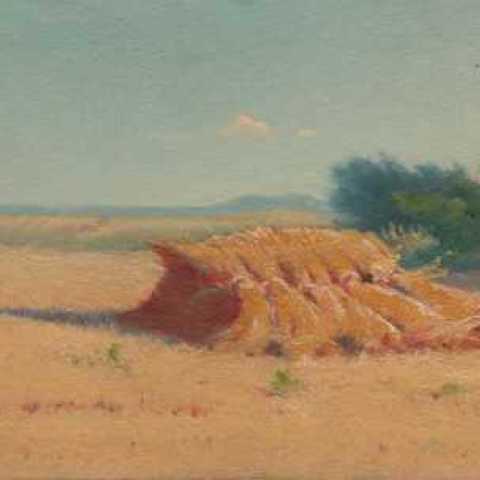Colnaghi
Colnaghi
26 Bury Street
St. James's
London
SW1A 1HE
United Kingdom






Colnaghi gallery is delighted to announce its representation of the largest collection of paintings by the French artist Edouard Athénosy (1859-1934) in existence, with an inaugural online exhibition of his fine miniature landscapes, to take place from the 22 March 2021.
Entitled Edouard Athénosy: Miniature Landscapes, it will include more than 20 paintings, and will be serve as a preview for physical presentations at the gallery’s spaces in London and New York later in Spring.
Athénosy was born in in 1859, in the mountainous and beautiful Saumane de Vaucluse region of southeastern France. This rocky and wild landscape had a deep impact upon Athénosy’s work, who depicted this terrain time and again, dominated by its oaks and blossoming shrubs.
Like his father, he began a career in public service, as an administrator in the local government of Avignon, working his way up to the head of the office of Préfet Louvel. Throughout his life, painting becomes his secret language and escape from this life of work and dutiful toil.
In 1878, Athénosy joined the Ecole des Beaux-Arts, Fine Arts School of Avignon, under the direction of Pierre Grivolas. His classmates and friends included the artists Claude Firmin, Roux-Renard, François Gauthier, amongst others. The quality of the training he received at the Beaux-Arts, his intense study from life and the antique, resulted in a precise and highly observant technique.
While Grivolas encouraged his students to follow the Impressionist track, Anthénosy was a faithful admirer of Corot and Felix Vallotton, maintaining his own distinct visual language. He lived a double life as an artist and worker; as director of the prefect’s office of Vaucluse, he escaped the anxiety for commercial success known by Monet or Pissaro. Instead, painting became his search for freedom from the constraints of his life of public service. Edouard Athénosy married in 1885 at the age of 26, three years after finishing his studies at the Beaux-Arts.
The recent discovery of tools and photographs of the artist, hidden for a hundred years in the false bottom of a drawer in his house in Les Angles, allow us to understand his practice. He worked en plein air with a palette, brushes, recently invented tubes of paint, and a frame which enabled him to go out and paint amongst nature. Most of the time he worked with a particular reduced and unchangingly small canvas size, which didn’t go above 7’’x 9.5’’. He wore a striking felt hat on his head, a black three-piece suit, and carried his paint box on his belt, and the box containing the small pictures attached to a loop.
The use of colour in Athénosy’s landscapes is particularly unique and sets them apart from his contemporaries. Unusually, the vast majority of his work uses oxide paints, which were not particularly practical, tending to ‘bleed’ on other colours. Brush cleaning between coats was also made difficult. We can see there a desire to move off the beaten track. His works are certainly miniature, but their technical prowess is remarkable.
Athénosy did not travel. He explored intimacy and depth in his local landscape of Les Angles, near his home. One of his favourite influences was Corot, and we see the influence of the neo-classical tradition within his concise, harmoniously laid out compositions. From 1911, he dedicates himself solely to the small format, which coincided with his retirement from work in the local government office. Now in his 50s, he was free to paint. The time he spent on his art is no longer counted. His small pictures become the pages of a secret diary, a « writing from the heart » where he communicates his oneness with nature.
Colnaghi is delighted to work with the European art consultancy, Ars Belga on this project, acknowledging the work of collector Guillaume Liffran, who rediscovered the artist in France, and has been working to rebuild his reputation for a number of years. In time, a committee will be established under his leadership, which will work to disseminate further research, archives, and the appreciation of Edouard Athénosy’s work.
Says Colnaghi CEO Victoria Golembiovskaya, ‘We are delighted to bring this under-recognised artist to greater public recognition, highlighting his own highly individual response to nature and unique place alongside the Impressionists. With three galleries, Colnaghi is well placed to stage presentations of artists work, bringing them to new audiences. Additionally, our relationships with major collections both public and private, allows us to place important paintings.’
